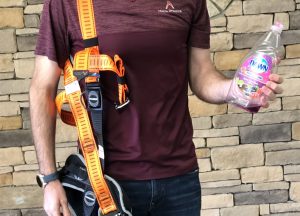Prevent the Spread of COVID-19: How to Clean Safety Equipment
David Ivey, Contributor
 These are strange times, with the idea of worker safety now coming to include a whole new dimension of minimizing contact with others and limiting the spread of germs among work crews. This new reality and the many challenges brought on by the current health crisis force us to rethink how we clean and maintain our facilities and gear—including personal fall protection equipment.
These are strange times, with the idea of worker safety now coming to include a whole new dimension of minimizing contact with others and limiting the spread of germs among work crews. This new reality and the many challenges brought on by the current health crisis force us to rethink how we clean and maintain our facilities and gear—including personal fall protection equipment.
We’ve been fielding a lot of inquiries about how best to clean our safety equipment, so we wanted to address some of the most common questions and concerns.
Best Cleaning Products for Safety Equipment
We recommend you check the manufacturer’s product instructions for care and maintenance, but here are some guidelines you can follow. Thankfully, you generally don’t need any special products—the best option is usually cleaning with tap water and mild soap, such as liquid dish detergent. This combination is effective in killing the COVID-19 virus; is inexpensive; and it’s safe for the integrity of the equipment.
You can use either cold or warm water, but avoid using hot water above 130° F (54.4° C), as this can damage the equipment. You don’t need to soak or submerge equipment—wiping it down with soapy water using a damp sponge will do the trick. Rinse with clean water to remove any soap residue. After cleaning, allow the equipment to hang-dry in an open, ventilated area to prevent mold or a musty odor. Do not machine-dry the equipment; this can also damage it.
Harsher cleaning products, such as rubbing alcohol, bleach, hydrogen peroxide, naphtha, turpentine or acetone, are not necessary and can damage the integrity of the material—these are NOT recommended for cleaning personal fall protection equipment of any kind. Avoid sanitizers, bleach and other industrial cleaning supplies.
How Often Should I Clean Safety Equipment?
Especially in this time of heightened risk from a potentially dangerous contagion, we recommend making cleaning your equipment a habit. Make it part of your process by adding it to inspection forms or work checklists.
Ideally, you can make cleaning part of the pre-use process, but the need to allow time for the equipment to air-dry can make this challenging—if you need to begin using it right away. You might consider adding a cleaning step to the process after you finish using the equipment each time. This should ensure that equipment is clean when you’re ready for it the next time. (As a bonus, any dirt, paint and debris that has soiled the gear will be that much easier to clean off, while it’s fresh.)
Relying on a cleaning regimen begs another question—how do I know the equipment was cleaned after its last use?
Should Employees Share Equipment or Have Their Own?
Normally, we recommend being fitted and having your own fall protection equipment; now it might be more important than ever for each worker to have and maintain his or her own personal fall protection equipment and other safety apparel (safety glasses, gloves, hard hats, etc.), in order to minimize contact between employees. If workers must share equipment, we recommend cleaning the gear between each use, before passing it on to the next employee.
Treating low-cost personal safety equipment, such as gloves and safety glasses, as disposable items may be another approach to minimizing the spread of germs via your team’s safety equipment. These items can be cleaned regularly, of course, but it might prove more cost-effective to simply discard inexpensive items at the end of a shift—instead of investing the time into disinfecting after each use.
Best Practices to Follow During The Pandemic
In general, we recommend workers follow the safety guidelines provided by the Centers for Disease Control (CDC) and the World Health Organization (WHO). Wash your hands regularly with soap and water for 20 seconds, or use hand sanitizer with an alcohol content of 60% or more. Whenever possible, maintain a physical distance of at least (2m) from other workers, even those who do not appear to be sick.
Although these are trying times, and the whole world seems upside down right now, we will get through the current health crisis together. Sooner or later, we expect that we’ll be able to get back to work without fear. In the meantime, practice good cleaning habits with your personal fall protection equipment to protect yourself and others from the danger presented by COVID-19 and, as always, stay safe. IHW
About the Author
David Ivey is the Product Engineering Manager for Malta Dynamics, where he oversees the engineering of all mobile fall protection and custom fall protection systems. For more information or with questions about OSHA compliance of fall protection systems, contact divey@maltadynamics.com.
Share on Socials!
Hearing Protection: Critical, but Often Unused
Maintain Injury-Free Jobsites Through Digital Compliance Processes
Breathing Easier with Digital Solutions
Leaders in Industrial Hygiene
Council for Accreditation in Occupational Hearing Conservation (CAOHC)
Subscribe!
Sign up to receive our industry publications for FREE!









